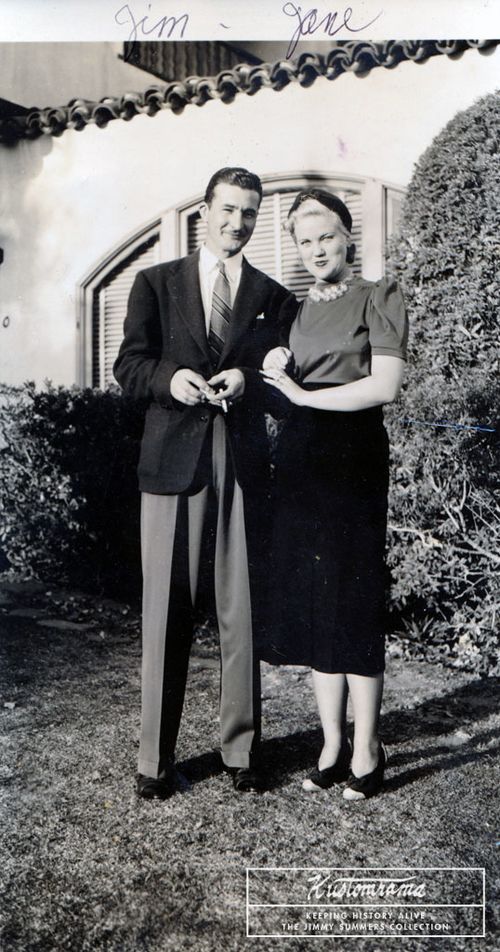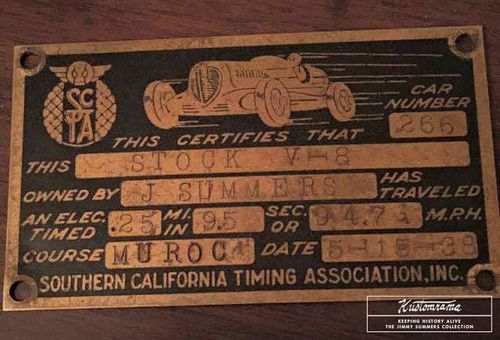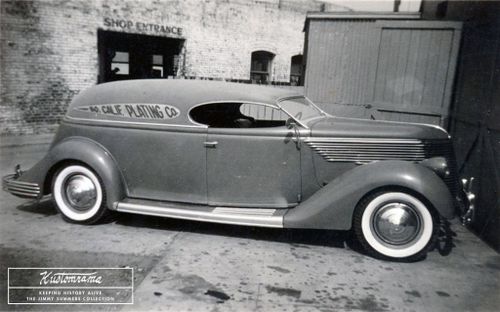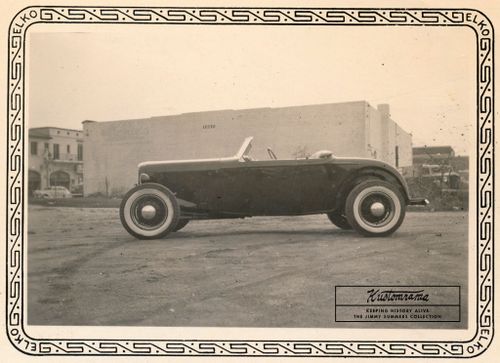
An early
1933 or
1934 Ford custom from Jimmy’s old album. Most likely an early custom job by Summers, modifications include fenders with modified wheel openings. Sheet metal has been added to the bottom part of the fenders and inside the wheel openings, making the fenders more massive and bulky, while the size of the wheel opening has been reduced. The top has also been
chopped, and it has been fitted with a
DuVall-type windshield. The stock headlights have been replaced with
1935-
36 Ford units, and it has been dressed up with solid hood sides, custom hubcaps, and chrome trim on the running boards. Photo courtesy of
Karen Smith.

A photo of a young Jimmy posing in a staircase.
Earl Bruce described Summers' shop as "
a dirty, filthy body shop owned and operated by one Jimmy Summers, who had the finest pair of hands on this planet." Lee and Kris recognized their dad in that description. "
His hands were always clean, and he never had a cut, bruise, or a broken bone in his hand. His hands were his life," Lee recalled. Photo courtesy of
Lee and
Kris Summers.

Jimmy in a race car. Karen believes that this was Jim’s car. Lee describes his dad as 6 feet tall and very slim. He was an active person that liked to go skiing, and he was fairly good at it. He also loved racing, and on the weekends, you would find him on the dry lakes chasing speed records. The back of this photo was stamped "
Hollywood Press Service. Photo by Ramsey. Sep 4, 1939." Photo courtesy of
Karen Smith.

According to Lee, an automobile accident damaged the lower part of Jim's leg; "
He broke the bones so bad that the doctors couldn't get it back together again well enough for him to continue racing." Jimmy is the gentleman with the helmet in this photo. Photo courtesy of
Karen Smith.

The grille shell on
Jimmy's roadster was bulged out at the bottom to hide the frame rails. It was also dressed up with a custom made nerf bar that featured the letter "S" for Summers. Photo courtesy of
Karen Smith.

Could this be another early
Summers of Hollywood custom? This
chopped 1938 Lincoln Zephyr Convertible Sedan has been dressed up with a
padded top,
1940 Ford headlights, and a later model, bulkier front bumper. The running boards have been removed, and chromed gravel guards have been installed to protect the fenders. The front end has also been dressed up with two fog lights and a grille guard. Photo courtesy of
Karen Smith.

A rather stock-looking Cadillac convertible photographed in front of Summers' shop. Photo courtesy of
Karen Smith.

A front end shot of the Cadillac. Photo courtesy of
Karen Smith.

Alex Xydias used to hang out at Jimmy’s shop in the early
1940s. Back then, Jimmy had a guy working for him named
Bob Fairman. Bob was called "Barbells," and according to Alex, he built a
chopped 1936 Ford that featured full
fadeaway fenders, like the Buicks of that era. Bob's Ford was the first custom with fadeaway fenders that Alex had seen.
Alex Xydias felt that Jimmy was the top customizer and car builder before the war; "
He did some remarkable things in his small shop, including building those solid rear fenders for my 1934 Ford cabriolet." Luckily,
The Fairman Coupe has survived, and after going through a restoration, it looks better than ever. Photo courtesy of
Karen Smith.

In
1947 Jimmy started offering
fadeaway fender kits for
1942-
1948 Chevrolets, Pontiacs, and junior Buicks.
Spencer Murray bought a set from Jimmy to put on his
1946 Chevrolet fastback, and he remembers that Jimmy had dies made to stamp the parts and a sheet metal shop to do the stamping. In
1948, Jimmy ran ads for his "
Summer Fender Extensions" in Hot Rod Magazine. According to the ads he ran, the fender panels served to enhance the body lines and inexpensively repair damaged or rusted doors and bodies. Fender extensions for Chevrolets, 1942 through 1948, were made in two types. "Type A" fit Aero Sedans, and "Type B" fit Convertibles, Coupes, and Tudor Sedans. A complete primered set came with brackets, nuts, bolts, patterns, and instructions for installation. The list price was $69.50. Photo courtesy of
Karen Smith.

Another photo of Jim and Jane. According to Lee, his dad had a thing for blonde girls. Photo courtesy of
Lee and
Kris Summers.

A construction photo of
Jimmy Summers' 1940 Mercury Convertible. Running
1945 plates, you can see that plywood is used behind the rear seat in the car. The back seat was made from scratch to provide better space after the body had been
channeled. The lettering on the deck lid reads, "Summers." Summers made a similar emblem for
Earl Bruce's 1940 Ford Coupe. The emblem on the coupe read “Bruce.” Photo courtesy of
Karen Smith.

An early front end shot of
Summers' Mercury. Kris told
Sondre that Jim only drove Buicks in the
1950s and the
1960s, so it probably wasn't a coincidence that the Mercury received a handmade
1939 Buick-looking grille that Summers made from flat stock. Photo courtesy of
Karen Smith.

A rare color photo of the green version of
Jimmy's Mercury from Lee’s collection. Jane did not like the Ruby Maroon color on the Mercury. So after Jimmy and Doane Spencer had an accident where they drove it down the steps at the state capitol in
Sacramento, she got Jimmy to repaint it green. Photo courtesy of
Lee Summers.

A photo of Jimmy and Lee.
Tom Sparks remembers Summers running his shop across
Fairfax High for about ten years, maybe into the early
1950s. He sold the
channeled Merc in
1950. A year or two later, he divorced Jane. "
I wasn't very involved with my father because my mother and him divorced, and my mother didn't want me to see him," Lee explained. "
I was 6 or 7 years old, and she didn't want me to have anything to do with my father." Photo courtesy of
Lee Summers.

A photo of Jim and Lee in a
1947 Cadillac. Jim didn't teach Lee how to do any automotive work. "
Dad didn't want me to learn the trade, as he didn't think it was worth learning or bothering with." Photo courtesy of
Lee Summers.
Before Barris, there was Summers. Nearly 100 years have passed since Jimmy Summers started practicing custom bodywork. Ed Iskenderian and Alex Xydias remember Summers as the most popular pre-war customizer in Southern California. Dan Post believes he might have been the first one. Summers had been restyling cars for nearly two decades when Robert E. Petersen launched Hot Rod Magazine in January of 1948. Early information about him is rare. Information published after 1948 is also very limited. Jim passed away in 1968, taking most of the stories with him. Luckily for us, he left a couple of photo albums behind. Thanks to the Summers Family, most of these photos have now found their way to Kustomrama.
"Dad was the third of seven siblings," Lee Summers told Sondre Kvipt of Kustomrama before heading into his bedroom to pull out the few photos that he has left from his dad. James Merlin Traft Summers was born on September 22, 1913, in Lewistown, Montana. "Everyone called him Jimmy. At home, he was Jim or dad," Lee's stepsister Kris shared with Sondre while they were waiting for Lee to return.
Jim's parents, Jack and Virna, came from Texas. His father was a farmer, and Jim grew up on a cattle ranch in Roy, Montana. "He didn't like that life at all," Kris' sister Karen told Sondre. "He didn't like the cold, and he didn't like riding horses." Jim was very intelligent, and he graduated high school when he was 14. "He could use both side of the brain," Karen explained. "Most people just use one or the other. He could do two things at the same time. He could be drawing and doing math at the same time - Using each hand!"
After Jim graduated, the Summers moved out West, settling down in West Salem, Oregon. Jim was too young to be admitted into a university, so he told Karen he would leave the family to go out explore, "riding on rails like a hobo." Somehow he wound up in California. Lee and Kris, who in 2019 lived together in a retirement apartment in Newhall, California, believed that their father moved to California on his own. "His younger brother Bill joined him later on," they told Sondre. In April of 1930, The Capital Journal newspaper in Salem reported that the Summers family was on their way south. Heading for California, "They did not appear to be sure of their final destination but will be on the move until they find someplace that suits them." The reason for the move was Jack's health. The Summers wanted to seek a place that would be of benefit to him.
How Jim started working on cars is a mystery. Lee remembered his dad telling him that he and his brother Bill became carpetbaggers in California. "They had tools in a bag, and they would go from block to block looking for cars that needed a fender repair." The brothers would knock on nearby doors and offer their services. "If the owners wanted a repair, Jimmy and Bill would straighten the fender for them on the street."
References
Kustomrama is an encyclopedia dedicated to preserve, share and protect traditional hot rod and custom car history from all over the world.


































